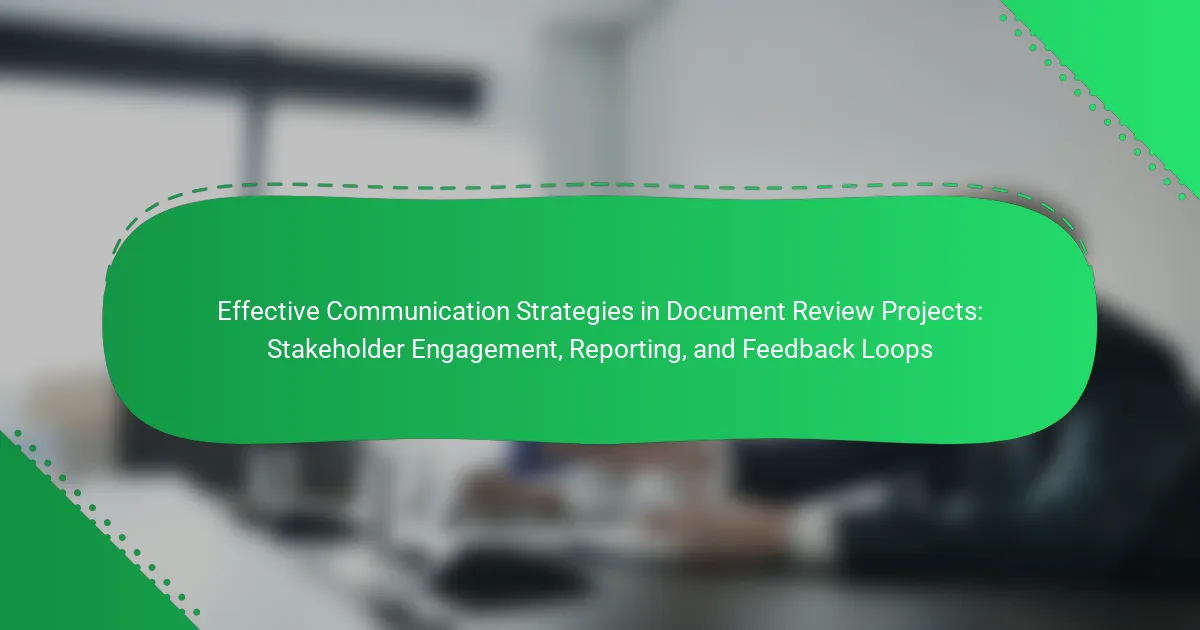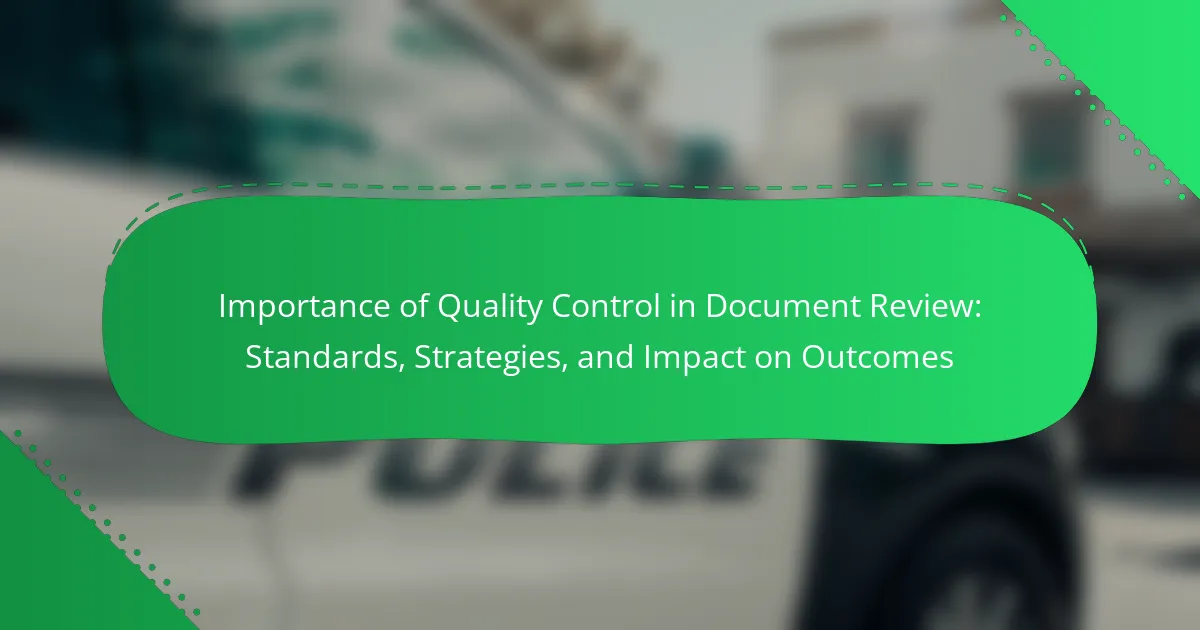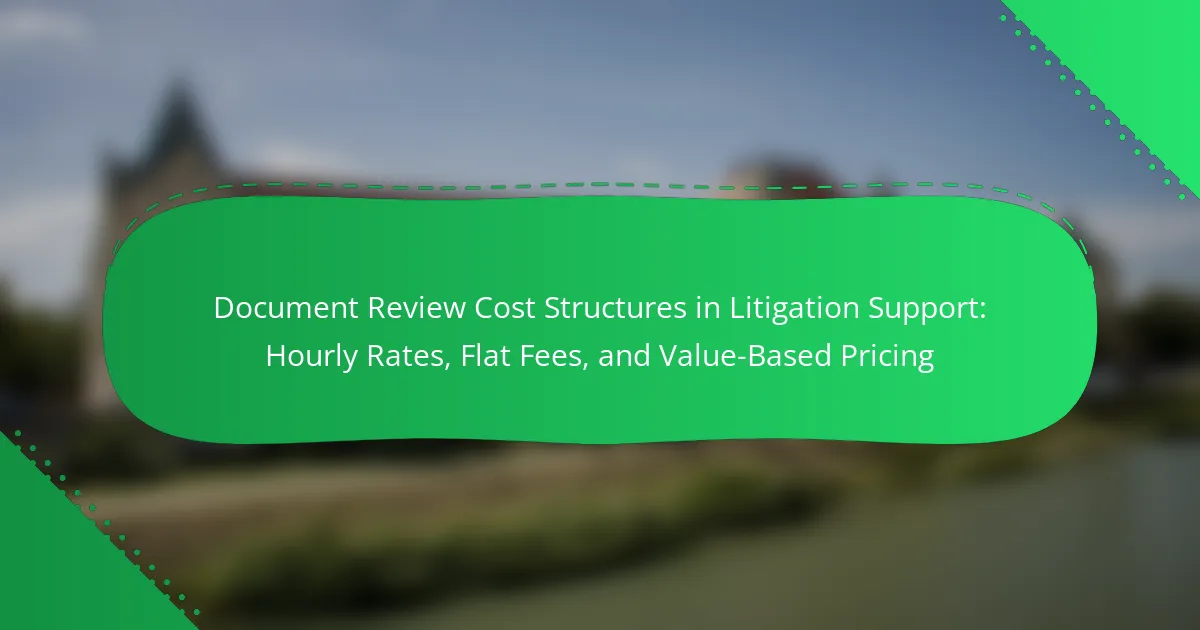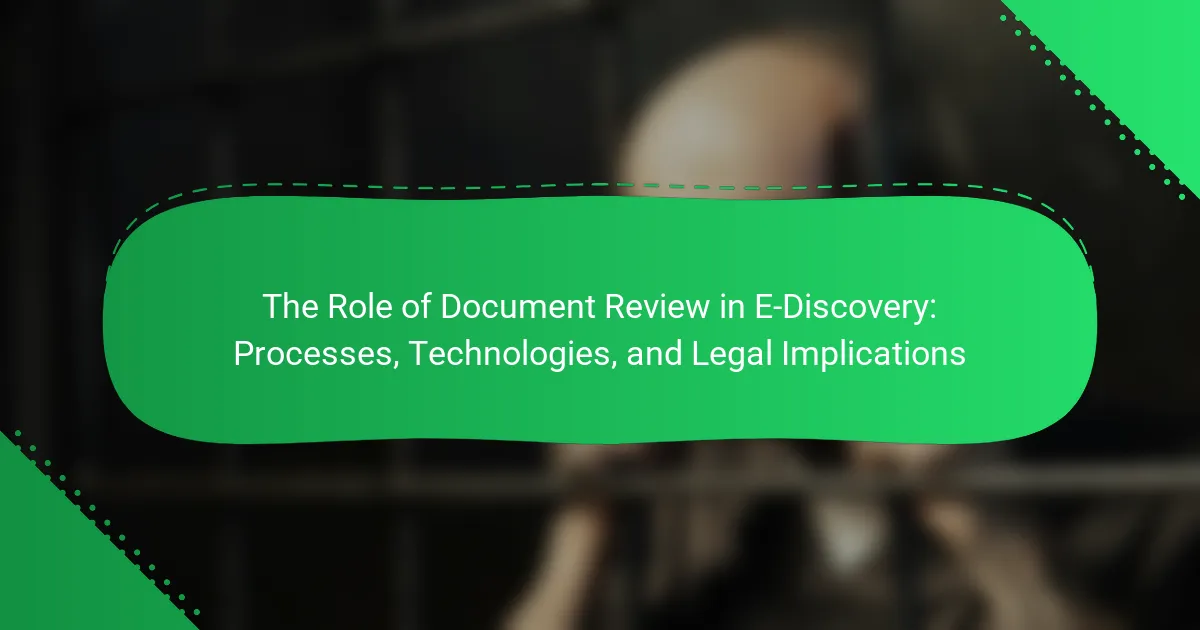Effective communication strategies are essential for successful document review projects, focusing on three key areas: stakeholder engagement, structured reporting, and feedback loops. Stakeholder engagement ensures that all participants are aligned with project goals and expectations, fostering trust through regular updates and transparent communication. Structured reporting provides concise summaries of progress and findings, keeping all parties informed. Additionally, established feedback loops facilitate continuous improvement by incorporating stakeholder input throughout the project lifecycle. These strategies collectively enhance the efficiency and effectiveness of document review processes.
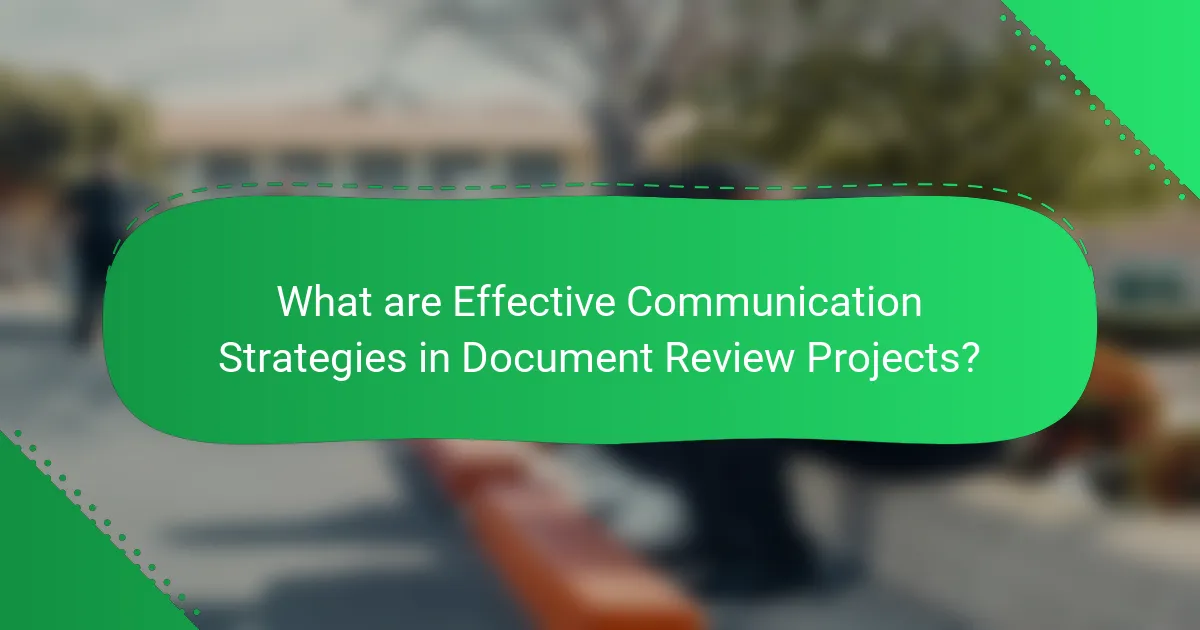
What are Effective Communication Strategies in Document Review Projects?
Effective communication strategies in document review projects include clear stakeholder engagement, structured reporting, and established feedback loops. Stakeholder engagement ensures all parties understand project goals and expectations. Regular updates and transparent communication foster trust and collaboration among stakeholders. Structured reporting provides concise summaries of progress and findings. This approach keeps everyone informed and aligned. Feedback loops allow for continuous improvement by incorporating stakeholder input throughout the project. These strategies enhance the efficiency and effectiveness of document review processes.
How do these strategies enhance stakeholder engagement?
Effective communication strategies enhance stakeholder engagement by fostering transparency and collaboration. Clear communication ensures that stakeholders are informed about project developments. This reduces uncertainty and builds trust among stakeholders. Regular updates and feedback loops allow stakeholders to express their concerns and suggestions. Engaging stakeholders in decision-making processes increases their investment in project outcomes. Research indicates that projects with strong stakeholder communication have a 20% higher success rate. Overall, these strategies create a more inclusive environment, leading to improved stakeholder satisfaction and project performance.
What role does clear communication play in stakeholder satisfaction?
Clear communication is essential for stakeholder satisfaction. It ensures that all parties understand project goals and expectations. This alignment reduces misunderstandings and conflicts. Effective communication fosters trust and transparency among stakeholders. Research shows that projects with clear communication have a higher success rate. For instance, a study by the Project Management Institute found that 80% of project failures are due to poor communication. Therefore, clear communication directly contributes to stakeholder satisfaction by improving collaboration and engagement.
How can communication strategies be tailored to different stakeholder needs?
Communication strategies can be tailored to different stakeholder needs by identifying their specific interests and preferences. Stakeholders may include clients, team members, or regulatory bodies. Each group has unique requirements for information. For instance, clients may need high-level summaries, while team members require detailed project updates.
Understanding stakeholder communication styles is crucial. Some stakeholders prefer visual aids, while others favor written reports. Adapting the format and frequency of communication can enhance engagement. Regular feedback loops allow stakeholders to express their needs and adjust strategies accordingly.
Research shows that effective stakeholder engagement improves project outcomes. According to a study by the Project Management Institute, projects with strong stakeholder engagement are 20% more likely to succeed. Tailoring communication strategies based on stakeholder analysis ensures that all parties remain informed and involved.
What are the key components of effective reporting in document review projects?
The key components of effective reporting in document review projects include clarity, accuracy, timeliness, and relevance. Clarity ensures that the report is easily understood by all stakeholders. Accuracy involves presenting precise information without errors. Timeliness refers to delivering reports within agreed-upon deadlines to maintain project momentum. Relevance means including only information pertinent to the project goals. Effective reporting also incorporates visual aids, such as charts and graphs, to enhance comprehension. Additionally, feedback mechanisms should be established to gather stakeholder input on the reports. These components collectively foster better decision-making and collaboration among project participants.
What types of reports are commonly used in document review projects?
Commonly used reports in document review projects include progress reports, summary reports, and issue tracking reports. Progress reports outline the status of the review process and highlight completed tasks. Summary reports provide an overview of findings and key insights from the document review. Issue tracking reports detail specific problems encountered during the review and their resolutions. These reports facilitate communication among stakeholders and ensure transparency throughout the project.
How can reporting formats impact stakeholder understanding?
Reporting formats significantly influence stakeholder understanding. Clear and structured formats enhance comprehension of complex information. Visual aids, such as charts and graphs, can simplify data interpretation. Consistent formatting helps stakeholders locate relevant information quickly. Conversely, poorly designed reports can lead to confusion and misinterpretation. Research indicates that stakeholders are 70% more likely to understand key messages when visuals are included. Effective reporting formats align with stakeholder needs, ensuring that critical insights are communicated effectively.
Why are feedback loops essential in document review projects?
Feedback loops are essential in document review projects because they ensure continuous improvement and accuracy. They facilitate ongoing communication between stakeholders, allowing for real-time adjustments. Feedback loops help identify issues early in the process, reducing the risk of errors. They also promote transparency, as stakeholders are kept informed of progress and challenges. Studies show that projects with established feedback mechanisms have higher success rates. For example, a report by the Project Management Institute indicates that effective communication can improve project outcomes by up to 20%. This demonstrates the value of integrating feedback loops in document review projects.
What are the stages of implementing effective feedback loops?
The stages of implementing effective feedback loops include identifying goals, collecting feedback, analyzing data, and taking action. First, stakeholders must define clear objectives for the feedback loop. This ensures that the feedback collected is relevant and actionable. Next, feedback is gathered from various sources, including team members and clients. This can be done through surveys, interviews, or direct observations. After collecting the feedback, it is essential to analyze the data to identify trends and areas for improvement. This analysis helps in understanding the effectiveness of current practices. Finally, stakeholders must take action based on the insights gained. Implementing changes ensures continuous improvement and closes the feedback loop.
How can feedback be structured to improve future document reviews?
Feedback can be structured by categorizing it into specific areas such as content, clarity, and format. Each category should have defined criteria for evaluation. For instance, content feedback can focus on accuracy and relevance. Clarity feedback can assess the readability and coherence of the document. Format feedback can evaluate adherence to style guidelines.
Using a standardized feedback form can ensure consistency. This form should include rating scales and open-ended questions for detailed insights. Regular training sessions can help reviewers understand how to give constructive feedback effectively.
Implementing a feedback loop allows for continuous improvement. This means using past feedback to inform future document revisions. Research shows that structured feedback increases the quality of outputs in collaborative environments. A study by Hattie and Timperley (2007) emphasizes that feedback must be specific and actionable to be effective.
How do communication strategies facilitate stakeholder engagement and feedback?
Communication strategies enhance stakeholder engagement and feedback by providing clear channels for interaction. These strategies include regular updates, targeted messaging, and active listening techniques. Regular updates keep stakeholders informed about project progress. Targeted messaging ensures that information is relevant to specific stakeholder groups. Active listening techniques encourage stakeholders to share their thoughts and concerns.
These strategies create a two-way dialogue between project teams and stakeholders. This dialogue fosters trust and transparency. According to a study by the Project Management Institute, effective communication improves stakeholder satisfaction by 20%. Enhanced engagement leads to more constructive feedback, which can improve project outcomes.
What challenges arise in communication during document review projects?
Communication challenges in document review projects include misalignment of expectations, unclear roles, and varying levels of stakeholder engagement. Misalignment occurs when team members have different interpretations of project goals. Unclear roles lead to confusion regarding responsibilities among participants. Varying levels of engagement can result in some stakeholders being more informed than others. These factors can create gaps in information sharing. Additionally, time zone differences may hinder timely communication. Inconsistent feedback can complicate decision-making processes. Lastly, technical issues with communication tools may disrupt the flow of information. Each of these challenges can negatively impact the overall effectiveness of the document review process.
What best practices can be applied to enhance communication in document review projects?
To enhance communication in document review projects, implement regular updates and feedback sessions. These sessions ensure all stakeholders are aligned on project progress. Utilize collaborative tools for real-time communication and document sharing. This facilitates immediate feedback and reduces misunderstandings. Establish clear roles and responsibilities among team members. Clarity in roles minimizes confusion and streamlines communication. Foster an open environment for questions and discussions. Encouraging dialogue promotes transparency and engagement. Schedule periodic check-ins to address concerns and adjust strategies as needed. This proactive approach can significantly improve project outcomes.
How can technology be leveraged to improve communication strategies?
Technology can enhance communication strategies by facilitating real-time collaboration. Tools like video conferencing and instant messaging allow stakeholders to connect instantly. Document sharing platforms enable simultaneous editing and feedback. This reduces delays in communication and decision-making. Analytics tools can track engagement and response rates. They provide insights into communication effectiveness. Automated reminders ensure timely feedback from stakeholders. Cloud-based solutions offer accessibility from any location. Collectively, these technologies streamline processes and improve stakeholder engagement.
What tips can ensure effective stakeholder engagement throughout the process?
Effective stakeholder engagement can be ensured by maintaining clear communication throughout the process. Regular updates keep stakeholders informed about project progress. Involving stakeholders in decision-making fosters a sense of ownership. Setting clear expectations helps align goals between the team and stakeholders. Actively seeking feedback allows for continuous improvement and addresses concerns promptly. Utilizing various communication channels caters to different preferences among stakeholders. Building relationships through personal interactions enhances trust and collaboration. Documenting stakeholder input ensures their perspectives are valued and considered.
Effective communication strategies in document review projects focus on enhancing stakeholder engagement, structured reporting, and implementing feedback loops. Key components include clear stakeholder engagement to align project goals, timely and relevant reporting to maintain transparency, and continuous feedback mechanisms to facilitate improvement. The article explores how tailored communication approaches can address diverse stakeholder needs, the significance of clarity in reporting, and the challenges faced during communication. Best practices and technological tools are also discussed to optimize communication processes and ensure effective stakeholder involvement throughout the project.
